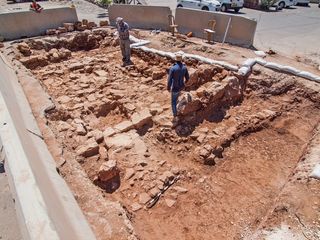Ancient Roman Road Exposed in Jerusalem

The worn-down flat stones of an ancient Roman road have been unearthed in Jerusalem, the Israeli Antiquities Authority (IAA) announced.
About 1,800 years ago, the road was one of two imperial arteries that connected Jerusalem to the ancient coastal city of Jaffa, now part of Tel Aviv. A well-preserved section of the path was exposed in northern Jerusalem during an excavation ahead of the installation of a drainage pipe, excavators say.
"Several segments of the road were previously excavated by research expeditions of the IAA, but such a finely preserved section of the road has not been discovered in the city of Jerusalem until now," David Yeger, who directed the excavation, said in an IAA statement.
"The Romans attached great importance to the roads in the empire," Yeger added. "They invested large sums of money and utilized the most advanced technological aids of the period in order to crisscross the empire with roads. These served the government, military, economy and public by providing an efficient and safe means of passage. Way stations and roadside inns were built along the roads, as well fortresses in order to protect the travelers."
The part of the road discovered in Jerusalem stretched 26 feet (8 meters) across and was bound on either side by curbstones, according to the IAA.
Though it has been largely covered up by modern development, parts of the road seem to have been in use long after the Romans left the region. For instance, the modern road in Bir Nabala, just northeast of Jerusalem, has been paved only a few centimeters above the ancient road, suggesting the Roman path had been used until a few decades ago, IAA officials said.
Israel's long history means archaeological salvage work is often necessary before construction projects break ground. Recent excavations have revealed a 2,000-year-old ritual bath, a Stone Age carving of a phallus, and animal figurines more than 9,000 years old.
Sign up for the Live Science daily newsletter now
Get the world’s most fascinating discoveries delivered straight to your inbox.
Follow Megan Gannon on Twitterand Google+.Follow us @livescience, Facebook& Google+. Original article on LiveScience.com.

